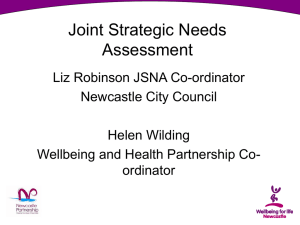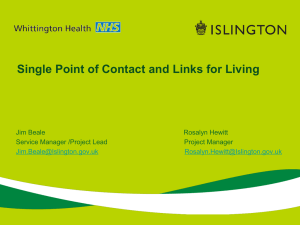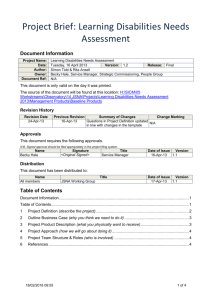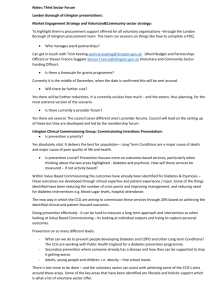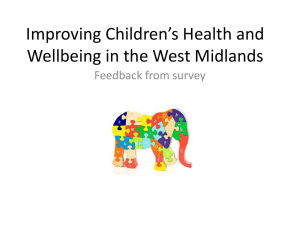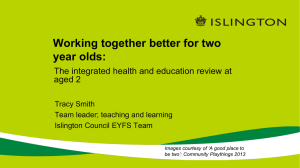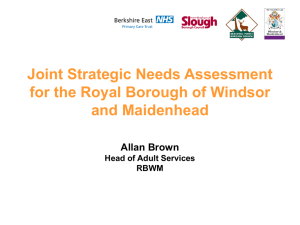JSNA Islington Summary report
advertisement
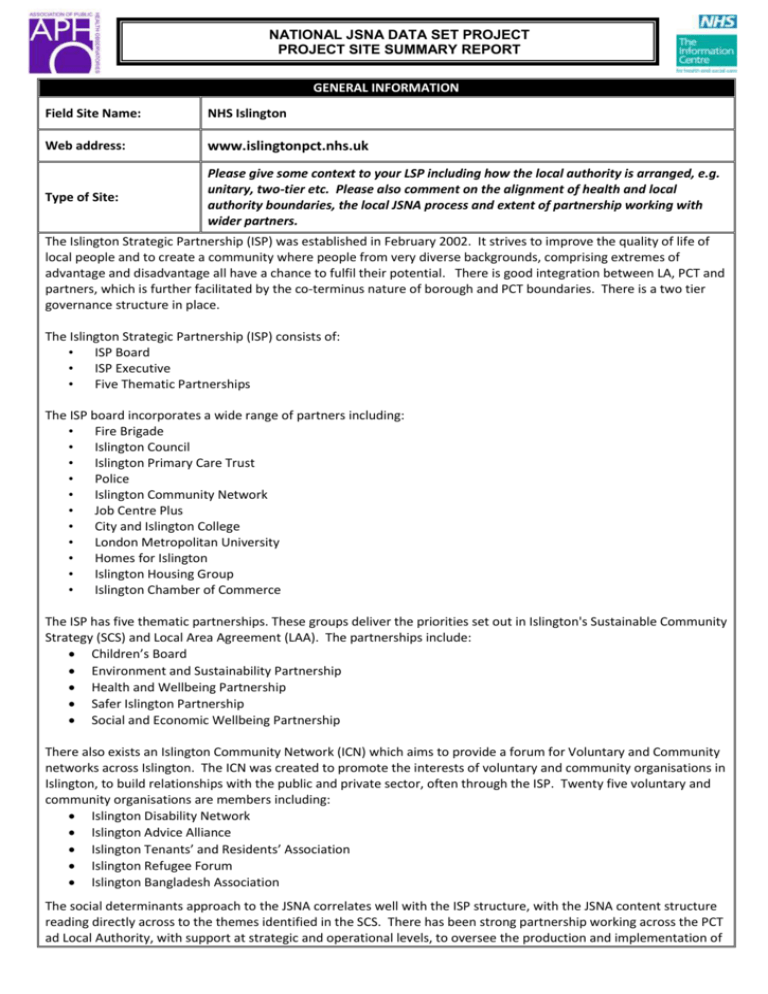
NATIONAL JSNA DATA SET PROJECT PROJECT SITE SUMMARY REPORT GENERAL INFORMATION Field Site Name: NHS Islington Web address: www.islingtonpct.nhs.uk Type of Site: Please give some context to your LSP including how the local authority is arranged, e.g. unitary, two-tier etc. Please also comment on the alignment of health and local authority boundaries, the local JSNA process and extent of partnership working with wider partners. The Islington Strategic Partnership (ISP) was established in February 2002. It strives to improve the quality of life of local people and to create a community where people from very diverse backgrounds, comprising extremes of advantage and disadvantage all have a chance to fulfil their potential. There is good integration between LA, PCT and partners, which is further facilitated by the co-terminus nature of borough and PCT boundaries. There is a two tier governance structure in place. The Islington Strategic Partnership (ISP) consists of: • ISP Board • ISP Executive • Five Thematic Partnerships The ISP board incorporates a wide range of partners including: • Fire Brigade • Islington Council • Islington Primary Care Trust • Police • Islington Community Network • Job Centre Plus • City and Islington College • London Metropolitan University • Homes for Islington • Islington Housing Group • Islington Chamber of Commerce The ISP has five thematic partnerships. These groups deliver the priorities set out in Islington's Sustainable Community Strategy (SCS) and Local Area Agreement (LAA). The partnerships include: Children’s Board Environment and Sustainability Partnership Health and Wellbeing Partnership Safer Islington Partnership Social and Economic Wellbeing Partnership There also exists an Islington Community Network (ICN) which aims to provide a forum for Voluntary and Community networks across Islington. The ICN was created to promote the interests of voluntary and community organisations in Islington, to build relationships with the public and private sector, often through the ISP. Twenty five voluntary and community organisations are members including: Islington Disability Network Islington Advice Alliance Islington Tenants’ and Residents’ Association Islington Refugee Forum Islington Bangladesh Association The social determinants approach to the JSNA correlates well with the ISP structure, with the JSNA content structure reading directly across to the themes identified in the SCS. There has been strong partnership working across the PCT ad Local Authority, with support at strategic and operational levels, to oversee the production and implementation of NATIONAL JSNA DATA SET PROJECT PROJECT SITE SUMMARY REPORT the JSNA. Primary JSNA contact(s): Rachel Maan, Public Health Strategist Renu Bindra, Assistant Director for Public Health Contact details: Rachel Maan Renu Bindra Tel: 020 7527 1244 Tel: 020 7527 1255 Email: Rachel.maan@islingtonpct.nhs.uk Email: Renu.bindra@islingtonpct.nhs.uk PROJECT DETAILS Project overview, outcomes and output: Please give a summary of the project you chose to undertake and why. Briefly explain the methodology for the work you have carried out, detailing the outcomes and outputs available to share nationally. The 2008 Islington JSNA had a number of strengths, for example it was strong on the use of evidence, partnership working with the Local Authority and the utilisation of quantitative information. However one of the major areas for development is around more effective and sustainable engagement with the community and voluntary sector. This is recognised as a long term goal, with the ultimate aim to develop strategies for more effective community and voluntary sector engagement through; fostering greater local ownership of the JSNA process and outcomes; listening to the third sector; empowering local people to voice their needs and maintaining on-going local engagement in the JSNA cycle. It is hoped this will lead to; priorities that reflect the needs of the local population; increased relevance of services for local people; improved uptake, quality and sustainability of services and stronger relationships with the local community. The pilot project was the first stage in this process. There were three main elements to the project, designed to help provide a baseline set of information to improve our understanding of health needs from the voluntary/ community perspective. The three elements included: 1. A third sector call for information – this was a request to share qualitative information telling us about third sector views of the health needs of the local population. A template and covering letter was sent to a wide network of community and voluntary organisations during August and September 2009. We set broad inclusion and exclusion criteria for the type of information we wanted to include. 2. An assimilation of existing material – we collated and analysed outcomes from relevant informal or formal engagement activities undertaken since 2006 within the PCT and Local Authority. Outcomes had to tell us something about needs in relation to health or the broader determinants of health within the community. Size, methodology and wider applicability of findings were used as criteria for inclusion. 3. A citizens panel – a questionnaire was sent to 1187 residents focusing on perceptions of health and healthy lifestyles, health behaviours, barriers to achieving a healthy lifestyle and recommended actions to facilitate health improvement. Results were weighted to reflect the local population. Implementation of the three strands of work was supported through meetings with key internal and external stakeholders, presentation at voluntary and community meetings, representation on JSNA steering group from LINk and voluntary organisation representatives. These activities were opportunities to raise awareness and understanding of the JSNA, as much as to promote opportunities for engagement. Outputs from the project work that will be available to share include the third sector call for information template, the citizens panel questionnaire, the report analysing the results of the citizens panel and the report drawing together the results from the third sector call for information and the assimilation of PCT and Local Authority engagement activities. NATIONAL JSNA DATA SET PROJECT PROJECT SITE SUMMARY REPORT What worked well? The shift to a more qualitative focus for the JSNA was embraced and recognised as an important priority by the Local Authority, PCT and third sector partners. Progress has been made with promoting greater awareness and understanding of the JSNA in the voluntary and community sectors and relationships are building with some of our key stakeholders such as the Local Involvement Network and Islington Voluntary Action Council. We have a baseline set of information and knowledge of where gaps exist in relation to perceptions of health needs from the community perspective, which has provided us with a platform from which to move forward. The third sector call for information was a useful exercise and helped us to better understand the structure and capacities of the third sector. It identified some useful information and more importantly highlighted some of the gaps we need to address in relation to the parties we need to engage. The assimilation of existing engagement material made the best use of available resources and brought together engagement activities in a way that hadn’t been done before across the Local Authority and the PCT. Common themes identified around access and inequalities. This has helped inform the future focus for engagement. The citizens panel had a 54% response rate and provided valuable insight and helpful in informing future strategy and service provision. Some of the factors which helped contribute to the project successes were: What didn’t work well? • Having an active and well structured voluntary sector with good channels of communication and receptive to engagement • Having a new Head of Communications and Engagement in post which was an opportunity to raise the profile of the JSNA, better engage with commissioning and to offer expertise to support the engagement processes • Having a history of strong partnership working with the Local Authority and support at senior levels in taking the JSNA forward • A willingness to share resources and support the engagement agenda across the PCT and LA The response to the third sector call for information was not as fruitful as anticipated. Some organisations struggled to understand the concept of the JSNA and therefore the purpose of the request which meant a lot of telephone calls and meetings were required to help generate responses. This technique tended to favour larger, better resourced organisations. Existing PCT / LA engagement material was available at the corporate level but harder to get hold of at the individual service level. Information tended to be patchy so was useful in supporting but not defining priorities. Timescales and capacity were an issue with resources being diverted away from the JSNA during the first wave of the flu pandemic, resulting in delays and timing becoming out of sync with commissioning processes. Owing to tight timescales engagement elements were undertaken in parallel to chapter writing making it difficult to pull the quantitative and qualitative aspects together. NATIONAL JSNA DATA SET PROJECT PROJECT SITE SUMMARY REPORT The JSNA project group set up was delayed and an earlier collective input from stakeholders would have been valuable. What would you do differently? What barriers did you have to overcome? Looking ahead, how has your JSNA work helped to prepare you A number of key messages came out of the pilot within Islington. These included: Having an early active dialogue with key stakeholders to test plans for engagement is important Identifying champions in different organisations and departments is useful to help collate information. Coupling existing information with an active dialogue is important to identify and prioritise health needs. Joint working with commissioning to have shared milestones/ deadlines is key • Knowing your local landscape in terms of the voluntary and community sector and then deciding how it can best be served • Emphasising what the JSNA can do for your voluntary / community partners is important- it isn’t just a one way process. An enhanced understanding of local population health needs can help organisations to better serve their communities • It is important to manage expectations when engaging with communities. The JSNA is a cyclical process and part of a wider mechanism to inform priority setting. Input needs to be seen in this context. • Feeding back to individuals/ organisations on how their input will be utilised not only builds good relationships but makes involvement in the future more likely • Balancing active dialogue with the utilisation of existing information is key to achieving an informed perspective on community views of health needs Barriers included: • Managing expectations of different stakeholders, particularly community and voluntary sector partners in relation to the outcomes from and process for engagement • The level of understanding within the voluntary sector and community of the JSNA process and the need to persuade some partners of the value of engaging with the process • The perception that the JSNA was a one off and a reluctance to repeat it again! • Competing priorities and lack of capacity on the part of authors to write their chapters • Rapidly changing environment – acute sector commissioning re-organisation to facilitate commissioning at the sector level In terms of QIPP and Total Place the JSNA has offered a very useful platform from which to move forward. In particular the evidence based approach adopted within Islington JSNA will prove a useful vehicle to ensure we invest in the most appropriate services and interventions. A whole system approach will be required to deliver the QIPP challenge and NATIONAL JSNA DATA SET PROJECT PROJECT SITE SUMMARY REPORT for the new policy landscape of "Total Place", QIPP, "Personalisation" and "World Class Commissioning"? JSNA is just one part of the process. We will need to do further work to bench mark and evaluate services, some of which has begun with programme budgeting. What concerns do you have about making your JSNA useful for this new context? The changing context raises a number of concerns about the JSNA and its role, in particular how you balance community perception of need with the organisational view and the drive to rationalise. Ensuring the JSNA is fit for purpose in a rapidly changing environment, particularly in relation to the move to sector and regional level commissioning and service provision, is a concern. The JSNA should be intrinsic to the WCC process. In Islington it has formed an important part of the WCC process and has been valuable in informing priority setting however there is further work to be done to improve the alignment of these processes. ADDITIONAL INFORMATION Please provide any additional information you deem useful, and any other relevant comments and list attached documents, presentations and web-links. Documents to be attached: the third sector call for information template the citizens panel questionnaire the report analysing the results of the citizens panel the report drawing together the results from the third sector call for information and the assimilation of PCT and Local Authority engagement activities presentation from the November pilot project workshop The JSNA will be available via Islington PCT website from March 2010. Please return completed forms to renata.muncey@ic.nhs.uk Many thanks for completing this form and for your engagement and enthusiasm for the project!
